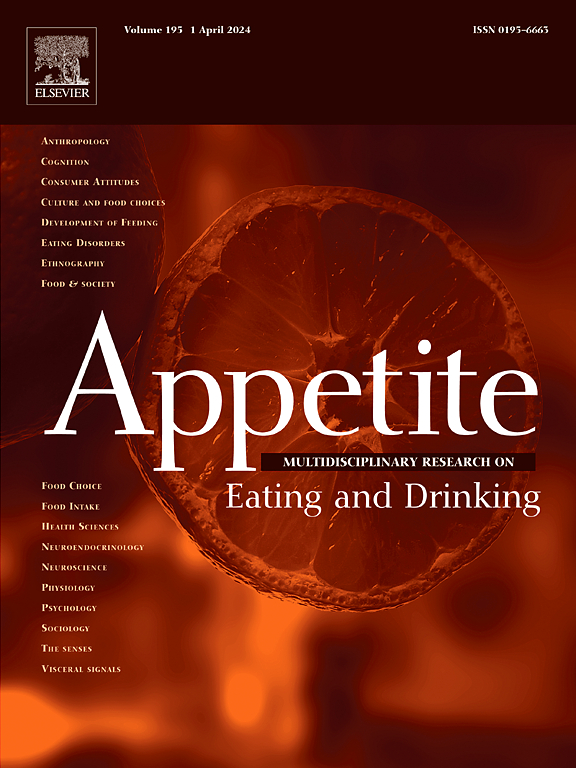情绪性进食的效价、多食与少食及情境因素:潜在特征分析。
IF 3.8
2区 医学
Q1 BEHAVIORAL SCIENCES
引用次数: 0
摘要
很少有情绪性饮食(EE)评估情绪效价(例如,积极的,消极的)和饮食行为(例如,吃得少,吃得多)之间的细微差别。此外,本研究试图通过使用潜在剖面分析来更好地表征积极和消极情绪进食者的亚群来解决这一差距。未选择的成人样本(N = 389;法师= 37.42;SD = 12.84)通过高产学术在线招募。参与者完成了情绪性饮食、痛苦不耐受、心理灵活性、饮食失调、失控、情绪失调、社会心理障碍和情绪性饮食相关因素的自我报告。潜在特征分析得出了四特征解决方案:1)低情绪进食(7%),负性暴饮暴食和正性暴饮暴食(16%),负性暴饮暴食和正性暴饮暴食(41%),适度情绪进食(36%)。回归分析表明,身体质量指数(BMI)和性别显著地预测了个体特征的成员关系,而卡方分析显示,饮食失调、心理社会障碍和背景因素(如情绪强度和物理环境线索)的水平在不同的情感表达特征中存在显著差异。研究结果强调了在饮食失调风险评估和干预措施开发中利用情绪饮食概况的重要性。本文章由计算机程序翻译,如有差异,请以英文原文为准。
Characterizing emotional eating by valence, over-vs under-eating, and contextual factors: A latent profile analysis
Few measures of emotional eating (EE) assess nuances within both emotional valence (e.g., positive, negative) and eating behaviors (e.g., undereating, overeating). Additionally, the present study sought to address this gap by using latent profile analyses to better characterize subgroups of positive and negative emotional eaters. An unselected sample of adults (N = 389; Mage = 37.42; SD = 12.84) were recruited online through Prolific Academic. Participants completed self-report measures of emotional eating, distress intolerance, psychological flexibility, disordered eating, loss of control, emotional dysregulation, psychosocial impairment, and emotional eating contextual factors. Latent profile analysis yielded a four-profile solution: 1) Low emotional eating (7 %), Negative overeating and positive undereating (16 %), Negative undereating and positive overeating (41 %), and Moderate emotional eating (36 %). Regression analysis demonstrated that body mass index (BMI) and gender significantly predicted profile membership, while Chi-Square revealed significant differences in levels of disordered eating, psychosocial impairment, and contextual factors (e.g., emotional intensity and physical-environmental cues) across EE profiles. Findings highlight the importance of utilizing emotional eating profiles in eating disorder risk assessment and development of interventions.
求助全文
通过发布文献求助,成功后即可免费获取论文全文。
去求助
来源期刊

Appetite
医学-行为科学
CiteScore
9.10
自引率
11.10%
发文量
566
审稿时长
13.4 weeks
期刊介绍:
Appetite is an international research journal specializing in cultural, social, psychological, sensory and physiological influences on the selection and intake of foods and drinks. It covers normal and disordered eating and drinking and welcomes studies of both human and non-human animal behaviour toward food. Appetite publishes research reports, reviews and commentaries. Thematic special issues appear regularly. From time to time the journal carries abstracts from professional meetings. Submissions to Appetite are expected to be based primarily on observations directly related to the selection and intake of foods and drinks; papers that are primarily focused on topics such as nutrition or obesity will not be considered unless they specifically make a novel scientific contribution to the understanding of appetite in line with the journal's aims and scope.
 求助内容:
求助内容: 应助结果提醒方式:
应助结果提醒方式:


